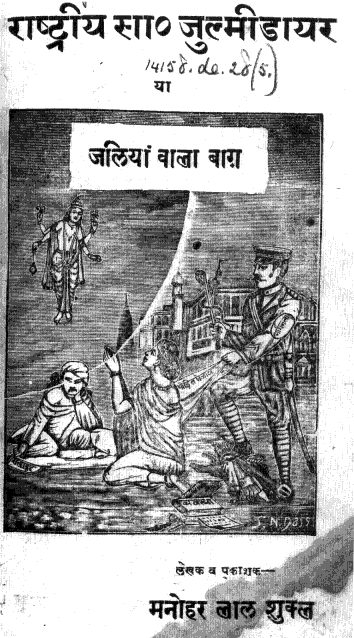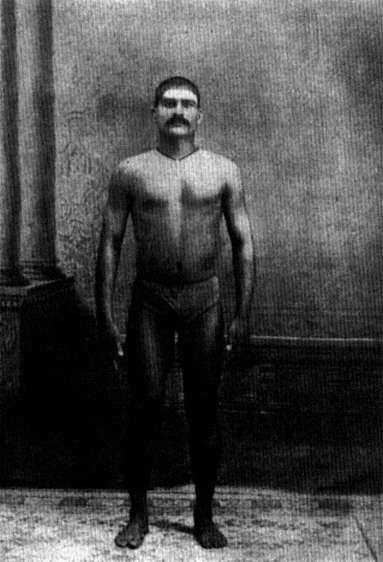Shrikrishna Khatri Pahalvan
Just as the Indarman akhara and its leader, Natharam, dominate the Hathras Svang, so Shrikrishna Khatri Pahalvan's name is synonymous with the Nautanki of Kanpur. As troupe organizer, actor, author, and

Fig. 12.
Title page of Rashtriya sangit julmi dayar by Manohar Lal
Shukla (Kanpur, 1922), on the incident at Jallianwala Bagh. By permis-
sion of the British Library.
publisher, his influence extended to all aspects of the Kanpur stage in the 1920s and continued for forty years or more.[54] It seems that Shrikrishna made his living as a tailor before he became firmly established in the Nautanki business. The reverse covers of several plays feature advertisements for his shop: "Every type of tailored clothing is sold wholesale, such as coats, shirts, kurtas, women's jackets, waistcoats, three-piece suits, two-piece suits, and so on." Obviously he was also a wrestler (pahalvan ). His Sangits carry a full-length portrait of the poet, standing in a proud posture clad only in a loincloth (fig. 13).
Shrikrishna's early plays dealt with historical figures such as Haqiqat Ray, Maharani Padmini, Shivaji, and Virmati, who defended Hindu faith and territory against Muslim armies and were in most cases martyred. At this time, Shrikrishna was under the influence of the Arya Samaj, a Hindu reform movement espousing the superiority of ancient Vedic civilization. Several of these plays were published expressly for the Arya Sangit Samiti of Kanpur, and the Samiti's name is listed on the covers. There are also internal references to the Samiti and the founder of the Arya Samaj, Dayanand Sarasvati. The mangalacharan of Maharani padmini (1919) concludes with: "May everyone spread the objectives of the Sangit Samiti." This play also closes with a moral lesson based on the promulgations of the Arya Samaj:
Friends, fellow Indians, awake from your stupor!
India produced goddesses like this one, who burned themselves
on the pyre and saved their honor.
If you wish the country to progress, take steps to preserve the Hindu faith.
Rani Padma was burnt to ashes. Hail Dayanand! The story is finished.[55]
Similarly, in Haqiqat ray , reported to be Shrikrishna's first play:
Look, friends, at Haqiqat's sense of duty.
He got beheaded to uphold the Vedic faith.
This only is my request: don't abandon your religion.
Hail Dayanand! The story is finished.
The cover page of Maharani padmini includes the following note: "Warning! It is strictly forbidden to perform this Svang with dancing." This unusual prohibition was probably intended to protect the reputation of the Arya Sangit Samiti, since it could not afford to be seen countenancing nach . (Dancing of course remained an important element in Kanpur Nautanki.) These texts indicate the strong influence of the Arya Samaj on the young Shrikrishna, when he accompanied his treatment of patriotic historical subjects, a feature of his output until around 1930, with a Hindu revivalist tone bordering on communalism.

Fig. 13.
Portrait of Shrikrishna Khatri Pahalvan of Kanpur, frontispiece to
Malkhan samar (Kanpur, 1920). By permission of the British Library.
Later he turned to the middle-class social milieu that characterized the comedies of the Parsi theatre, choosing characters from the nouveau-riche Seth class and their servants, as well as government employees, students, and other contemporary figures. Examples of these subjects in the London collections are "The Eye's Magic" (Ankh ka jadu ), "Devotion to the Husband" (Pati bhakti ), "The Loyal Accountant" (Vafadar munim ), "The Valiant Manjari" (Shrimati manjari ), "The Punjab Mailtrain" (Panjab mel ), "Flute Girl" (Bansuri vali ). Some of these stories were based on current Parsi plays or film hits.
The title page of Virmati (1921) contains the characteristic doha of Shrikrishna's early plays:
The imprint gives information on the name and the mark;
Inside is the photo of Shrikrishna Pahalvan.
The same play mentions two important co-writers in the colophon:
Panna the poet's pen has stopped and Lakshmi Narayan says it is
morning.
A number of early plays are listed under the dual authorship of Pannalal Shrikrishna; possibly Pannalal's contribution was comparable to that of Ruparam who worked for Natharam of Hathras. Lakshmi Narayan's name stands alone in the colophons of several Sangits. As with the other famous poets, it is impossible to determine which plays published under Shrikrishna's picture are truly his own compositions.
In the early days, Shrikrishna's plays were published by Umadatt Vajpeyi, the leading popular press in Kanpur, but eventually he opened his own publishing concern, Shrikrishna Pustakalay in the Chauk. According to his son, Pooranchandra Mehrotra, who now operates the press, seventy-five million copies of Shrikrishna's books were published and sold up to 1971. A 1987 publication, Sangit vir vikramaditya , lists over one hundred Sangits of the Great Shrikrishna Sangit Company. Shrikrishna received the annual award of the Sangeet Natak Akademi, Delhi, in 1967.
Another popular poet of Kanpur, judging from the London collections, was Chhedilal, who often composed with Devidas. Seven of his Sangits, mostly on older themes like Laila majnun, Sultana daku, Amar simh rathor , and Virmati , were published between 1928 and 1932. Other Kanpur poets like Madhoram Gulhare appear to have been competing with Shrikrishna as the popularity of Nautanki spread in this region.